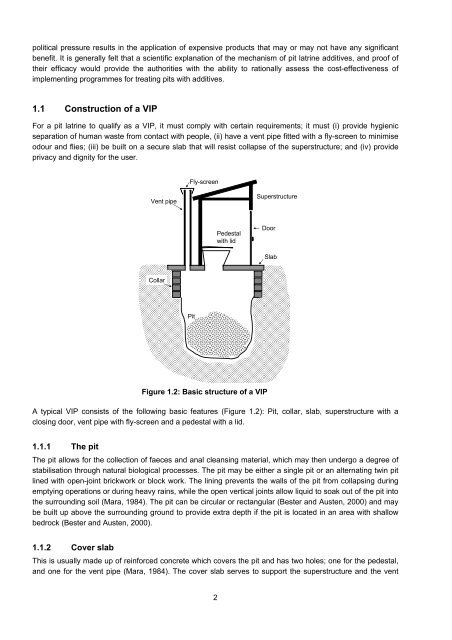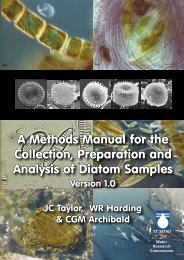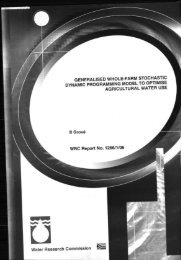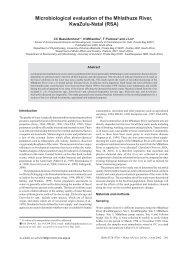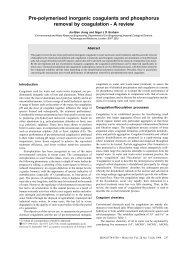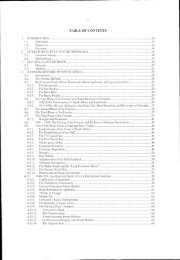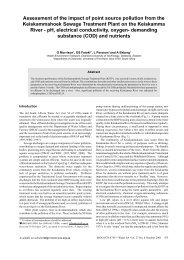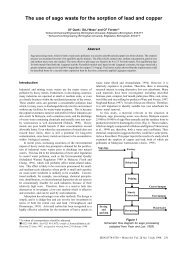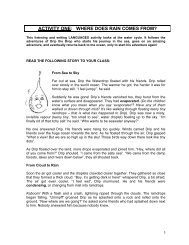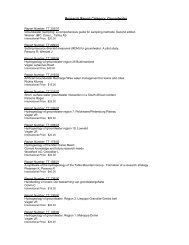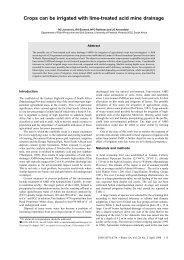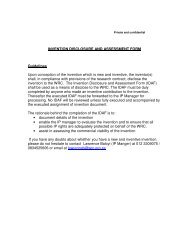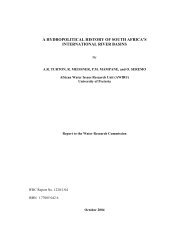and the Efficacy of Pit Latrine Additives - Water Research Commission
and the Efficacy of Pit Latrine Additives - Water Research Commission
and the Efficacy of Pit Latrine Additives - Water Research Commission
- No tags were found...
Create successful ePaper yourself
Turn your PDF publications into a flip-book with our unique Google optimized e-Paper software.
political pressure results in <strong>the</strong> application <strong>of</strong> expensive products that may or may not have any significant<br />
benefit. It is generally felt that a scientific explanation <strong>of</strong> <strong>the</strong> mechanism <strong>of</strong> pit latrine additives, <strong>and</strong> pro<strong>of</strong> <strong>of</strong><br />
<strong>the</strong>ir efficacy would provide <strong>the</strong> authorities with <strong>the</strong> ability to rationally assess <strong>the</strong> cost-effectiveness <strong>of</strong><br />
implementing programmes for treating pits with additives.<br />
1.1 Construction <strong>of</strong> a VIP<br />
For a pit latrine to qualify as a VIP, it must comply with certain requirements; it must (i) provide hygienic<br />
separation <strong>of</strong> human waste from contact with people, (ii) have a vent pipe fitted with a fly-screen to minimise<br />
odour <strong>and</strong> flies; (iii) be built on a secure slab that will resist collapse <strong>of</strong> <strong>the</strong> superstructure; <strong>and</strong> (iv) provide<br />
privacy <strong>and</strong> dignity for <strong>the</strong> user.<br />
Fly-screen<br />
Vent pipe<br />
Superstructure<br />
Pedestal<br />
with lid<br />
Door<br />
Slab<br />
Collar<br />
<strong>Pit</strong><br />
Figure 1.2: Basic structure <strong>of</strong> a VIP<br />
A typical VIP consists <strong>of</strong> <strong>the</strong> following basic features (Figure 1.2): <strong>Pit</strong>, collar, slab, superstructure with a<br />
closing door, vent pipe with fly-screen <strong>and</strong> a pedestal with a lid.<br />
1.1.1 The pit<br />
The pit allows for <strong>the</strong> collection <strong>of</strong> faeces <strong>and</strong> anal cleansing material, which may <strong>the</strong>n undergo a degree <strong>of</strong><br />
stabilisation through natural biological processes. The pit may be ei<strong>the</strong>r a single pit or an alternating twin pit<br />
lined with open-joint brickwork or block work. The lining prevents <strong>the</strong> walls <strong>of</strong> <strong>the</strong> pit from collapsing during<br />
emptying operations or during heavy rains, while <strong>the</strong> open vertical joints allow liquid to soak out <strong>of</strong> <strong>the</strong> pit into<br />
<strong>the</strong> surrounding soil (Mara, 1984). The pit can be circular or rectangular (Bester <strong>and</strong> Austen, 2000) <strong>and</strong> may<br />
be built up above <strong>the</strong> surrounding ground to provide extra depth if <strong>the</strong> pit is located in an area with shallow<br />
bedrock (Bester <strong>and</strong> Austen, 2000).<br />
1.1.2 Cover slab<br />
This is usually made up <strong>of</strong> reinforced concrete which covers <strong>the</strong> pit <strong>and</strong> has two holes; one for <strong>the</strong> pedestal,<br />
<strong>and</strong> one for <strong>the</strong> vent pipe (Mara, 1984). The cover slab serves to support <strong>the</strong> superstructure <strong>and</strong> <strong>the</strong> vent<br />
2


